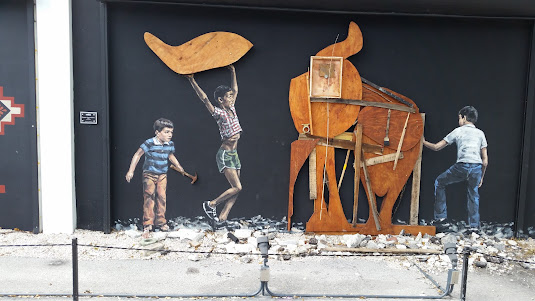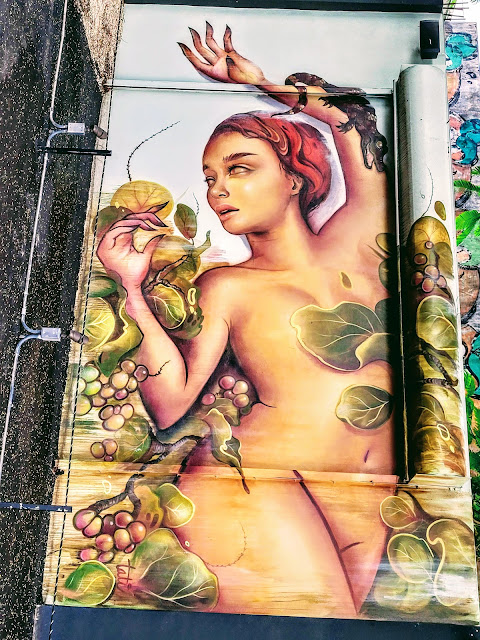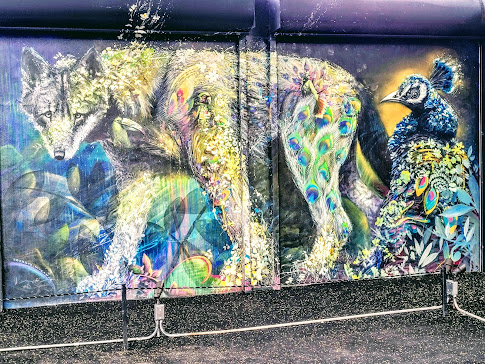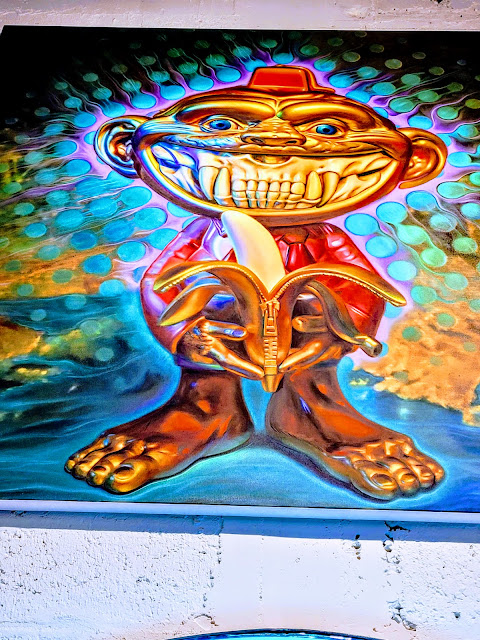Before the plandemic, A number of gringos and Cuencanos had an interest in wanting to clean the buildings in El Centro of tagging. Tagging is generally when teens spray paint on walls and buildings with phrases like "Jose loves Maria" or "Kilroy was here", "or political statements like "down with the gutless mayor", or whatever phrases or pictures or diddling capture their fancy. Surprisingly and delightfully, in Cuenca, it was and is rare to find obscenities and graphics of explicit sex like in many American inner cities. In Cuenca, almost every home is surrounded by enclosed walls, so there are endless opportunities for teen male mischief. Graffiti, as opposed to tagging, is when some "budding artist" attempts a serious spray painting of content that usually is what I call comic book art forms of bubblisized figures and creatures. However, these are sometimes placed on walls without permission.
What surprised me is that when I moved to Cuenca in March of 2011, tagging and graffiti were very rare. Along the banks of the Rio Tomebamba on Third de Noviembre a new monument of stone of no great import was constructed shortly after my arrival. By August of that year, the monument was defaced in various colors of spray paint. It was after that incident that tagging began spreading across the city. No more than an owner would repaint his outer walls around his home, the tagging would reappear again within days. It didn't take long for the home owners and business owners to surrender to the tagging, as it became too expensive and time consuming to repaint every time the tagging reappeared. The worst was in El Centro, even the sacredness of the New Cathedral was not spared from the tagging of its lower level as high as the tagging culprits could reach or spray.
In 2019, as the tagging and graffiti became worse, civic-minded citizens began to organize and step in and voluntarily clean and scrub the tagging from the various buildings and walls of El Centro. Discussions and debates were held as to whether to punish the culprits, or at least to find venues for the serious graffiti artists to express themselves in places in the city where the municipal government or private owners would give permission for their walls to be adorned. Some of the graffiti was good and some left much to be desired. All along the escalares leading from El Centro down to the Tomebamba river, on the walls along the river of Third de Noviembre, and on city and private property authorized graffiti began to appear.
The tagging was greatly reduced, and much of the discussion was put on hold as the plandemic hit the world, and the lockdowns brought to a standstill any serious concern about graffiti, which suddenly seemed to be a miniscule problem. There are walls and buildings in Cuenca which have the bubblisized art characteristics, and others that appear to be murals with rather literal representations.
Now that the lockdowns are hopefully over for good, whether the graffiti will get more attention in Cuenca, I do not know. However, some of the problems with graffiti is that being out in the open, they do invite taggers with no talent of their own to spray and mark over parts of the graffiti. After all, tagging, unfortunately, was meant to be anti-establishment and illegal or unauthorized. Another problem for the graffiti is the fact that it is outside art, which is at risk of the elements of weather and car exhaust, which over times the art gets dirty or begins to fade from its initial brilliant colors. Some graffiti chips away on the plastered walls as well.
My first taste of graffiti art, where I began to appreciate it as art and not just an ugly annoyance, was in Wynwood Walls, a neighborhood in Miami. The museum by the same name is considered the first graffiti museum. The complex is surrounded by walls, and within these exterior walls, there are panels of walls within the compound almost like a maze to walk around and take in the experience in an outdoor setting. I thought what a wonderful idea this would be for Cuenca as an additional tourist attraction, if one could find the land of at least a half a block and the money to finance it. Such an open-air museum doesn't have to be in El Centro, but within a mile or two of it. Imagine an area just off the tranvía, and how convenient it would be for tourists to have easy access to the museum. Ideas like this require civic and business leaders to have imagination and be willing to think outside the box, and show initiative to get such projects off the ground, and not take years to complete.
Wynwood Walls Museum now charges $12 as a regular price in Miami. One can tour it in as little as twenty minutes. However, I like to study the art, read the captions, and take photos; so I easily spend a wonderful hour or more at the museum. It is one of the places I always visit now on my trips to Miami, a city I love a great deal. Of course, I only travel to Miami from November through March. By April the hot, humid weather is insufferable. The cost of living also makes Miami attractive to visit, but not as a place to live. Oh, and did I overlook those occasional hurricanes that streak across Florida.
This Wynwood Museum chooses graffiti artists who paint their exhibits, which are allowed to stand for almost a year. In November of each year most of the previous art is replaced with new art, often by new artists, which may take a few months before all the previous year's art is replaced. The area around the museum is bustling with discos, restaurants, cafes, dress shops, etc. The businesses are generally affordable to young entrepreneurs just starting out. It is very safe with police presence and undercover police in the area as well. Unfortunately, about three blocks down from the museum the area is gentrifying, so I don't know what that will mean for these businesses and the museum in the future as the gentrification continues to move in their direction and the rents begin to go sky high. It is also sad that some of the best art is demolished each year to make way for the new art. I must take a Buddhist attitude on this, that like the beautiful Mandalas that Buddhist monks make from sand, and when completed are almost immediately swept away by their hands or by a rake to show the impermanency of all things.
The photos below are from the exhibit of February 2016, when I first visited the museum: The first two photos were my absolute favorite.
Waywood Museum October, 2021 VISIT
I had the opportunity to visit Waywood Museum again this past October. The art was more dazzling than ever, and I didn't recall a building on the site before, but there was one this time. It had more art variety, including some paintings done on canvas, some painted in acrylic, and there were antiques as well, which were not your everyday antiques. For me, it was an exciting experience.
There is no parking lot for the museum, so people park along the curbs on the streets wherever they can find an open parking space, which sometimes may take them a couple of blocks in various directions to find an open parking spot. As I parked and was walking toward the museum, I could already see these mammoth murals over-hanging the museum.
This work below is another of my favorites. It reminds me of the Garden of Eden. The temptation of the sensuous. The woman is robust and full-bodied as women were presented in Renaissance art. Yet she has a lizard on her arm, and her fingers are like claws. She has unwittingly bargined with the devil, gained the knowledge of good and evil, and in the process has lost her soul.




























































































No comments:
Post a Comment
Note: Only a member of this blog may post a comment.